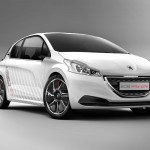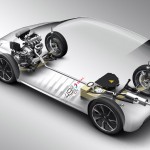Colin Chapman, of Lotus Cars fame, is famous as saying, “add lightness” when speaking of his designs and creating some of the world’s most competitive road and racing cars. It seems Peugeot have been adhering to that philosophy very closely with the new 208 HYbrid FE, set to be on show at the IAA 2013 Frankfurt Motor Show in a couple of weeks time.
Although Peugeot have gone to great lengths to reduce the weight of the standard 208 in order to increase fuel economy, they haven’t done this without losing a few parts along the way. Namely, power steering, braking assistance and air conditioning have all been sacrificed in the name of economy.
It is interesting to note that those particular items have been deemed extraneous as none were included as standard in cars such as the Peugeot 205 back in the 1980’s. Back then, cars didn’t have luxuries like power steering as they weren’t needed as they were lightweight, unlike a lot of today’s cars. Not the fault of manufacturers, of course, it has been as a result of increased safety measures and many other considerations that simply weren’t factors when building cars back in the 80’s.
So, how to make a car that is lightweight yet safe, fast but economical and still give the same levels of comfort and space as the donor car upon which it is based? Now that’s a challenge and Peugeot think they’ve found the answer.
Peugeot have gone to great lengths to write up all of their achievements and developments with the 208 HYbrid FE, which they are rightfully proud of. So, sit back, grab a cup of tea and relax as this is a long and technical explanation all about the car down to the finest detail!
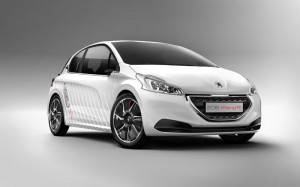
Starting with a 1.2 litre 3 cylinder petrol engine in it’s heart, mated together with powerful electric motors, the 208 HYbrid FE gives exceptionally good performance more associated with a ‘hot hatch’, yet giving less CO2 than an eco warrior.
The Research and Development teams of both Peugeot and Total rose to the challenge by establishing a remarkable level of performance, based on a production Peugeot 208 hatchback: 0 to 62mph in 8.0 seconds and CO2 of just 49g/km over the official NEDC European Drive Cycle (Combined Cycle figure).
Numerous innovations are implemented in several areas:
- Aerodynamic properties: improvements of 25% for the CdA,
- Weight: reduction of 20%,
- Powertrain: 10% improvement in fuel economy,
- Hybridisation: recovery of 25% of the energy over one drive cycle.
“The 208 HYbrid FE project is essential as it explores solutions for reaching the bar of 141mpg. It also showcases our R&D work with our historic partner Total. Together, we are developing more economical vehicles, we are winning victories all over the world. Together, we are making good progress.”
Said Maxime Picat, Director General, Automobiles Peugeot.
“With the 208 HYbrid FE, Peugeot and Total are combining their expertise to offer the technical solutions of tomorrow. Energy efficiency is a strategic aspect for our Group as it is at the heart of the expectations of our customers, who wish to enjoy the benefits of efficiency and yet retain driving pleasure. It is also a response to contemporary environmental challenges and the means of preserving fossil fuels, which are precious resources.”
Added Philippe Boisseau, member of the Executive Committee, President of Marketing & Services and New Energies department at Total.
Since 1995, Peugeot and Total have been working extensively together to significantly increase fuel economy, improve CO2 emissions and the TCO (Total Cost of Ownership) of motor vehicles. Peugeot’s long-standing environmental policy is to reduce their overall weighted average emissions. This year already, on its European ranges, Peugeot have lowered their CO2 average down to 116.3g/km at the end of May, compared to 121.5g/km in 2012 and the figure is continually decreasing. Their target (as has been set by EU Policy to all car manufacturers) is 95g/km on a weighted average of the new vehicles sold in Europe in 2020; so they’re well on the way to achieving that low figure.
Total’s researchers have been hard at work developing future motor vehicle fuels and lubricants, such as friction reducing compounds that have contributed to a 5% reduction in CO2 emissions in the last ten years with Peugeot engines.
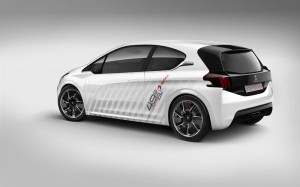
The objective of the 208 HYbrid FE (the FE stands for Fuel Economy) is to halve the CO2 emissions of the Peugeot 208, equipped with the 1.0-litre VTi 68bhp and to provide it with acceleration comparable to a performance hatchback, so quite a challenge!
Already being a lightweight car in it’s class, the 208 was a special challenge for those involved in the making of the HYbrid FE.
“The goal of 49g and acceleration from rest in 8.0 seconds is as difficult to achieve as victory on the other side of the world. The small team consisting of the best experts in each of the areas brought all of its creativity and enthusiasm into play, and we did it!”
Said Bruno Famin, Director, Peugeot Sport.
The aerodynamics on the 208 HYbrid FE have been fettled by experts in wind tunnels. The net result? Improvements of 25%, to a drag Cd value slightly lower than 0.25, impressive considering neither passenger space nor boot space were affected by the changes! What’s a slight shame is the same aerodynamics were not applied to the ordinary 208.
With lots of tweaks all over the body, here there and everywhere, including a modified intake air flap that diverts air differently than on the normal 208. Any flow disrupting components has been eliminated to help improve the aero performance on the body sides. Specially developed tyres by Michelin are tall and narrow, reducing drag by being more narrow and allowing for less resistance when rolling. The 19” alloy wheels to which the tyres are fitted, feature carbon aerodynamic flaps that fill the space between each spoke. Due to their dimensions, the 145/65 R19 wheels themselves reduce the rolling resistance by 20%. Not only that, but due to the narrow tyres and lightweight car, power steering has been deemed an unecessary extra – reducing power required to run the system by the engine, thus increasing economy.
As we’ve seen attempted several times before, namely on some Ford prototype electric cars and the Tesla Model X crossover, rear facing cameras replace conventional wing mirrors. The captured image in displayed on the interior mirror reminiscent of sporting disciplines like endurance racing. However, it is currently a legal ligislation in countries like America to have wing mirrors, so until that law is changed, unfortunately good ol’ untechnical mirrors will have to return for the US market.
Further enhancements reduce drag even more, such as the design of the roof which extends in almost horizontally leading into the tailgate spoiler and air deflectors on the rear and a very race car like completely under belly. Finally, thin vertical fins over the LED lamps minimise air flow turbulence.
Aside from aerodynamics, Peugeot’s engineers worked in cooperation with many other companies specialising in composite materials. The result of analysing every component to see where weight could be reduced, but not at the compromise of safety or comfort, was a saving of a massive 20%.
Composite components replace bodywork panels and the floor, further reducing the weight of the body shell from 295 to 227kg. The one-piece outer skin (weighing just 20kg), the flat base (8kg), the door panels (2kg) and the lower front panel are made from carbon fibre. The bonnet (5kg) and the wings (2.1kg) are constructed from a composite VER/Carbon, a material which is half the weight but with comparable structural properties. It is obtained from a new type of resin which can be used untreated, painted or colour-dyed.
Finally, with the exception of the door windows, the glazing uses polycarbonate to further save 5kg. The 208 HYbrid FE innovates in its use as this material has up until now been reserved for headlight lenses. It reduces the weight by more than 50% compared to conventional glass.
Innovative suspension and wheels
The 208 HYbrid FE rests on innovative pseudo MacPherson suspension with a ‘glass fibre resin’ composite transverse-located blade. It replaces several components: suspension springs, lower wishbones and anti-roll bar. The front blade also has varying flexibility along its length. Designed and produced by Hutchinson, using these two blades saves 20kg alone.
The wheel rims house large brake discs 380mm in diameter and 9.6mm thick. They are rigged with two-piston callipers, 44.5mm at the front and 31.8mm at the rear. On braking, the reduced effort on the pedal and the intervention of the electric motor mean that the supplementary braking assistance can be eliminated.

A passenger compartment for five occupants
The 208 HYbrid FE needed to retain the interior features of the production hatchback model. The result proves it: a very economical vehicle that can comfortably accommodate five people and their luggage. Only the air conditioning is eliminated due to its impact on fuel consumption.
The composite door trim pads are developed by Total’s Polymers Division using Polypropylene reinforced with natural fibres. Its excellent structure, rigidity and impact absorption properties are accompanied by a reduction in weight of up to 15% and mean a reduction in the carbon footprint of these components. The centre console and vent trims are of VER resin (CCP Composites) left untreated to offer an appearance not previously seen before. In fact, their slightly amber honey colour reveals the natural fibres through transparency. The weight reduction techniques have also been applied to the petrol engine and the gearbox.
An efficient and high-performance power train
The 208 HYbrid FE is driven by a petrol-electric powertrain, which combines development of the latest generation of 3-cylinder engine with a battery and an electric motor taken from Peugeot Sport’s Endurance programme. Special engine management and special software control the entire drive train. Overall, the efficiency of the powertrain increases by an impressive 10%.
“The challenge of this project consisted of combining engine optimisations (reciprocating gears, cylinder head, etc.) and optimising the flow of energy between the internal combustion engine and the electric motor. All of the solutions can potentially be carried over to production.”
Said Julien Lidsky, Manager, 208 HYbrid FE Powertrain, Peugeot Sport.
1.2-litre VTi-FE petrol engine of high efficiency
The 3-cylinder engine has undergone several modifications: optimisation of the engine operational cycle, reduction of friction losses and thermo-management. All of these advances lead to fuel economy improvements by 10% yet with power maintained at 68bhp (50kW).
The Miller Cycle is accentuated and the compression ratio modified from 11:1 to 16:1 to increase the engine’s thermodynamic efficiency. This can lead to self-ignition of the mixture (or knock), which is potentially destructive. To prevent this, several actions were taken.
The rate of unburned elements in the combustion chamber is reduced by valves of increased diameter, exhaust pipes are redesigned, as is the manifold, and an adapted valve lift pattern is introduced. Furthermore, the heat exchanges are optimised in the cylinder block by means of coolant passages arranged between the cylinders. The coolant now passes through the cylinder head along its entire length to recover the heat around each source: combustion chambers, between injectors and spark plugs.
The engine adopts direct injection which, by means of very precise phasing with the closing of the cylinder, maximises the benefit of each molecule of fuel. The variable setting at the inlet and at the exhaust extends the range of optimum efficiency to the entire engine speed range, both at full load and partial load.
However, not all of these various developments favour power at high engine speed. So, the capacity is modified to 1,233cm3 by increasing the bore and the stroke (75mm x 93mm) to maintain the declared 68bhp (50kW). On the other hand, this progress benefits the maximum torque produced which increases by 25%.
All of the moving components are specific to the 208 HYbrid FE. The nitrated steel crankshaft, the titanium con rods and the aluminium-copper alloy pistons are cut from solid. So, their weight is reduced in spite of the increase in capacity; the con rods and Gudgeon pins being halved.
The friction losses are a challenge as they represent approximately 1/5th of the power consumed by an engine. On the 208 HYbrid FE, they are reduced by approximately 40% notably by the crankshaft, the pistons and the Gudgeon pins, the piston rings and the camshaft followers. These components are given a diamond-like Carbon coating and are geometrically optimised.
The weight of the cylinder head, also cut from a solid block, is halved due to the reduced thicknesses permitted by its design and the characteristics of the aluminium used. The coolant circuit and the inlet line are made by rapid prototyping of resins charged with glass fibres or carbon. To do this, the laser beam of a 3D printer fuses successive layers of aluminium powder. This produces a functional component quickly and more cheaply in the context of individual specialised manufacture.
Produced using the same process, the piston base jets serve here both to cool them on use under load and to heat the oil as quickly as possible on starting.
This virtuous circle affects all of the areas explored by this technological demonstrator. So, the size of the radiator is reduced, benefiting the aerodynamic properties. The alternator, the starter and the reverse gear are eliminated, reducing the weight and overall dimensions.
Piloted transmission
The base of the production piloted manual gearbox is retained for its high efficiency and its integrated actuators. The casings cut from a solid block house a cascade of gears to connect the electric engine to the differential crown wheel. To reduce friction losses, the teeth of the gears are given a tungsten carbide chrome coating.
Greasing is redesigned to reduce the volume of lubricant necessary and prevent splashing over the gears, which also consumes energy. Now, the lubricant is moved to the highest point by the final drive crown wheel before circulating through gravity over the entire mechanism. The prototype gearbox oil is developed by Total Lubricants based on bio-sourced oils, of 75W grade with a very high viscosity index (higher than 250). This produces a 3% reduction in consumption, and becomes a preview of lubricants of the future. Taken directly from a competition environment, a fluid grease of low density also reduces the quantity deemed necessary. Its longevity is assured by operation at a lower temperature due to a reduction in friction and finally, the hub bearings adopt a special fluid grease, which adheres but limits friction losses.
Fuel and lubricant
The 208 HYbrid FE passes the CO2 emissions cycle with a benchmark Super 95 fuel. The performance additives of the Excellium type, developed by Total Additives and Special Fuels, would alone reduce the CO2emissions of this engine by more than one additional gramme per kilometre.
“The 208 HYbrid FE offers a convergence of innovations from the laboratories of Total. Today, the group’s researchers are developing biofuels, energy saving lubricants (Fuel-Eco lubricants) and special additives all contributing to improving fuel economy. In France, close to 250 researchers are working on developing the products of tomorrow.”
Said Philippe Montantême, Senior Vice President Marketing and Research Strategy, Marketing & Services department at Total.
A special engine oil of extremely low viscosity has been developed by Total Lubricants using ultra-fluid based oils and by the addition of friction reducing agents containing molybdenum. Of grade 0W12, this oil develops its properties very rapidly with a shorter temperature rise time. Optimised as regards friction, it retains, both when hot and when cold, an advantage compared to the best products on the market. Thus improving fuel economy, here again a few more grammes are saved!
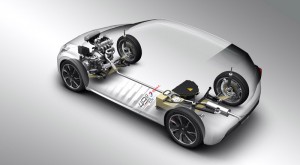
A hybridisation taken from endurance experience
The project has benefited from the expertise of Peugeot Sport with its experience acquired in endurance competition. So, the electric motor and the battery are those developed for the Peugeot 908 HYbrid4 endurance race car for example.
“The hybridisation developed for the 908 HYbrid4 is state-of-the-art in this domain. The work consisted of integrating it within the power train to recover as much energy as possible on braking and using its full potential on acceleration.”
Said Pierre Lebrene, Manager, 208 HYbrid FE Energy Recovery System, Peugeot Sport.
The electric machine combines power and lightness as, at only 7kg, it develops 30kW as a motor and 100kW as a brake generator. In both modes, its torque reaches a maximum of 30Nm. Proportional to the speed of the vehicle, its maximum speed is 40,000rpm. The electric motor provides the reverse gear function, by inverting the direction of rotation, and the starter function. It also provides access to ZEV driving, purely electric.
The Lithium-ion battery, which has a capacity of two usable MJ or 0.56kWh, consists of 0.56 cells of 90V each. They are arranged in groups, which permit the ability to isolate one if deemed necessary. To ensure that this strategic unit is cooled correctly, Total has developed a special oil for circulating in the dedicated radiator.
Weighing 25kg, it is installed, with the 20-litre petrol tank, on a subframe which is bolted underneath the vehicle directly below the rear bench seat. Here, sporting experience is demonstrated with improved weight distribution. For the inverter and the ECU, these are installed under the bonnet in the space left free by the braking assistance. The hybridisation has no effect on the interior packaging, so inside the vehicle passenger space is maintained.
The principle of operation
During deceleration phases, whether by releasing the accelerator pedal or through braking, the vehicle is slowed down primarily by the electric motor. The hydraulic braking only comes into operation at the end of braking phase to maximise the recovery of the energy available. Over one homologation cycle, this recovery is 25%. Then, on acceleration, this energy is returned and assists the petrol engine according to various parameters: acceleration dictated by the driver and the gear selected.
The 208 HYbrid FE, Fun&Efficient and Fuel Efficiency
The Peugeot and Total teams, who have been working for months on creating this technological demonstrator, can be justifiably proud.
The emissions of CO2 are just 49g/km with the different areas divided up as follows:
- weight reduction, aerodynamic properties and tyres: 40% (<20g),
- hybridisation: 40% (<20g),
- engine and gearbox: 20% (<10g).
The performance aspect, which improves from 14 to 8 seconds over the 0-62mph exercise is also contributed to by:
- weight reduction, aerodynamic properties and tyres: 4.0 seconds,
- hybridisation: 2.0 seconds.
The 208 HYbrid FE proves itself beyond the figures. Due to the virtuous circle in which the two partners became involved, the driver enjoys new experiences at the wheel of this technological demonstrator: acceleration worthy of a GTi with mixed fuel economy of 112mpg. Without any loss of comfort or ease of use, the driver will rediscover a direct link with the road due to the elimination of the powered, energy-consuming assistance.
“At the beginning of the project, the objective seemed very ambitious, of a very high level. It was! The two partners, Peugeot and Total, achieved it by combining their technological expertise. Peugeot Sport has contributed its expertise to the project and has identified new areas of development. Production and Competition are progressing together.”
Said Christophe Mary, Technical Manager of the 208 HYbrid FE project, Peugeot Sport.
Source; Peugeot
